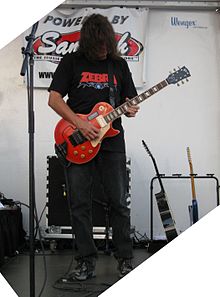Open G tuning

Amongalternative tuningsfor the guitar, anopen G tuningis anopen tuningthat features theG-majorchord;itsopennotesare selected from the notes of a G-major chord, such as the G-major triad(G,B,D). For example, a popular open-G tuning is
- D–G–D–G–B–D (low to high).
An open-G tuning allows a G-major chord to be strummed on all six strings with neither fretting of the left hand nor a capo. Like other open tunings, it allows the eleven major chords besides G major each to be strummed bybarringat most one finger on exactly one fret.[1]
Usages in music
[edit]Open G tuning allows for open strings and single-fret bar chords to be played in key which make techniques such asslideandsteel guitarviable. Open G tuning is common inbluesandfolk music[2](along with other open tunings).[1][3]
Open G tuning particularly common in guitar music ofHawaiianorigin including guitar styles such asslack-key guitarandsteel guitar.In the context of slack-key music, open G is often referred to "Taro Patch" tuning (the term stems fromtaro,a traditional staple cuisine ofPolynesianHawaii). However, guitar is not a traditional Polynesian instrument; it was introduced to Hawaii byvaqueroshired byKing Kamehameha IIIto assist with the nascent Hawaiian ranching industry in the mid 19th century.
Mark Knopfler,ofDire Straits,used the open G tuning on "Walkin' In The Wild West End" and "Romeo and Juliet", though, in both songs, the open chord was the IV (subdominant,) chord, not the home (tonic) chord of the song. On "Romeo and Juliet", a capo was placed on the third fret.[citation needed]

Repetitiveopen-G tunings are used by Russian guitars,Dobro guitars,andbanjos.They repeat three open-string notes.
The repetitive open-G tuning
- D–G–B–D–G–B–D

is used by theRussian guitar,which hasseven stringstuned mostly in triads, in contrast to other guitars, which are tuned mostly in fourths.[4][5][6]
Dobrosuse a full six-string tuning with a bottom G: G–B–D–G–B–D, low to high. The two lowest strings are, accordingly, tuned three semitones higher for the lowest string (from E up to G) and two semitones higher for the second-lowest string (from A up to B) while the highest string is tuned two semitones lower (from E down to D), relative tostandard tuning.
Five-stringbanjo's standard tuning is also an Open G: g–D–G–B–D, where the lower case "g" denotes the highest-pitched "drone string",physically located next to (above) the lowest-pitched string, the first upper case" D ".[7]
Alan Sparhawk of Low has been using an Open G tuning his entire musical career, since being inspired by Sonic Youth as a kid.[8]
Overtones of the fundamental note G
[edit]

Bad CompanyguitaristMick Ralphshas used another open-G tuning, which listed the initial sixovertonesof the G note,
- G–G–D–G–B–D
- for "Hey Hey" and while writing the demo of "Can't Get Enough".[9]

The overtones tuning G–G–D–G–B–D was used byJoni Mitchellfor "Electricity", "For the Roses", and "Hunter (The Good Samaritan)".[10]Truncating this tuning to G-D-G-B-D for his five-string guitar,Keith Richardsplays this overtones-tuning onThe Rolling Stones' "Honky Tonk Women","Brown Sugar"and"Start Me Up".[11]American rock bandEagles of Death Metal,uses this tuning for the majority of their songs.[12]
See also
[edit]- Minor thirds tuning
- Scordatura,alternative tunings of stringed instruments
- Stringed instrument tunings
Notes
[edit]- ^abSethares (n.d.,p. 16)
- ^Denyer (1992,p. 158)
- ^Denyer (1992,p. 160)
- ^Bellow (1970,p.164):Bellow, Alexander (1970).The illustrated history of the guitar.Colombo Publications.
- ^Timofeyev, Oleg V.(1999).The Golden Age of the Russian Guitar: Repertoire, performance practice, and social function of the Russian seven-string guitar music, 1800–1850.Duke University, Department of Music. pp. 1–584. University Microfilms (UMI), Ann Arbor, Michigan, number 9928880.[page range too broad]
- ^Ophee, Matanya (ed.).19th Century etudes for the Russian 7-string guitar in G Op.The Russian Collection. Vol. 9. Editions Orphee. PR.494028230.;Ophee, Matanya (ed.).Selected Concert Works for the Russian 7-String Guitar in G open tuning.The Russian Collection. Vol. 10 ( "X" ). Editions Orphee. PR.494028240.
- ^http://opendtuning.com/open-g-tuning-dgdgbd/
- ^Sparhawk, Alan."Low—full performance (live on KEXP)".YouTube.Retrieved4 August2023.
- ^Sharken, Lisa (15 May 2001)."Mick Ralphs: The rock 'N' roll fantasy continues".Vintage Guitar.Retrieved21 February2013.
- ^"List of all Guitar and Piano Transcriptions".GGDGBD.JoniMitchell.com.RetrievedFebruary 22,2013.
- ^Ellis, Andy (2005)."How to play like... Keith Richards".Guitar Player.Retrieved24 March2013.[permanent dead link]
- ^"Eagles of Death Metal's Jesse Hughes: Special Forces Ringmaster".Premier Guitar.22 October 2015.RetrievedMarch 9,2020.
References
[edit]- Denyer, Ralph (1992). "Playing the guitar ('How the guitar is tuned', pp. 68–69, and 'Alternative tunings', pp. 158–159)".The Guitar Handbook.Special contributorsIsaac Guilloryand Alastair M. Crawford (Fully revised and updated ed.). London and Sydney: Pan Books. pp. 65–160.ISBN0-330-32750-X.
- Sethares, William A.(n.d.)."Alternate tuning guide".Madison, Wisconsin: University of Wisconsin; Department of Electrical Engineering.Retrieved19 May2012.PDF
Further reading
[edit]- Weissman, Dick (2006).Guitar tunings: A comprehensive guide.Routledge.ISBN9780415974417.LCCN0415974410.[permanent dead link]
